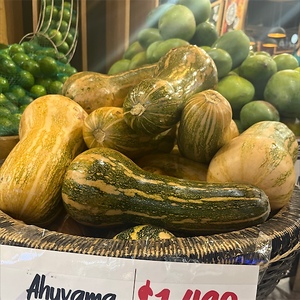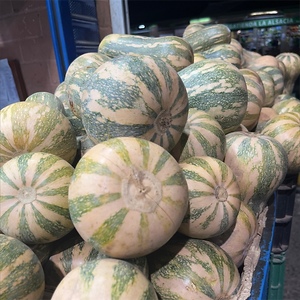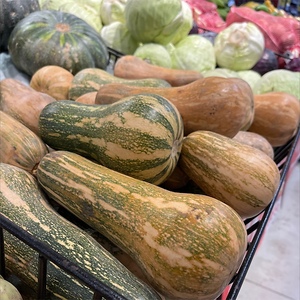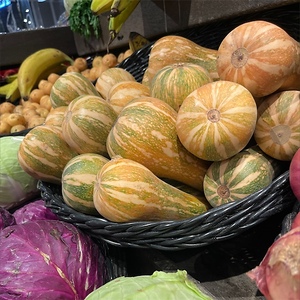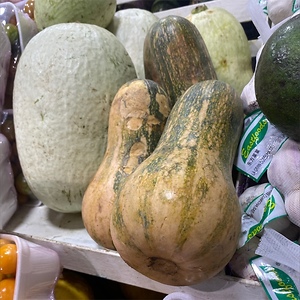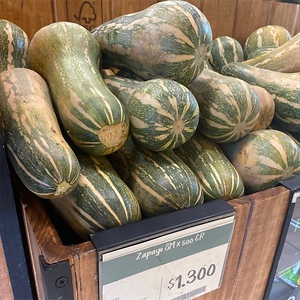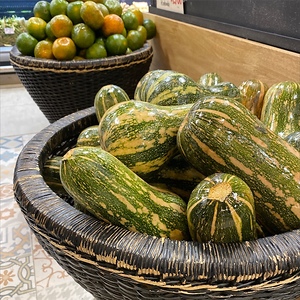


Ahuyamin Squash
Estimated Inventory, lb : 0
Description/Taste
Ahuyamin widely varies in appearance, depending on the specific variety, and can range from elongated, curved, and bulbous, to round, oval, to cylindrical in shape. The rind is generally smooth, semi-thick, and firm, varying in color from dark green to tan, and some varieties also bear mottled and variegated vertical stripes. Underneath the surface, the flesh is dense, crisp, slippery, and dark orange to golden-orange, encasing a small cavity filled with stringy membranes and pointed, flat, and oval, cream-colored seeds. When cooked, Ahuyamin softens, developing a smooth and creamy consistency, and has a sweet, subtly nutty flavor.
Seasons/Availability
Ahuyamin is available in the dry season of Central and South America. In some tropical regions, the squashes can be cultivated year-round.
Current Facts
Ahuyamin, botanically classified as Cucurbita moschata, is a general descriptor used for many different squash varieties belonging to the Cucurbitaceae family. Cucurbita moschata is one of the most cultivated species of Cucurbita in the tropics, native to Central and South America, and was spread around the world through explorers and trade. In South America, the most diverse collection of Cucurbita moschata varieties is found within Colombia, where both heirloom and hybrid squashes are cultivated. Ahuyamin is also known as Auyama and Ahuyama, and many different varieties of squash are generally labeled under these names in local markets throughout South America, Central America, and the Caribbean. Generally labeling the squash is meant to simplify the purchasing process for consumers, and the squashes sold under the Ahuyamin name are primarily local varieties sold for everyday culinary applications.
Nutritional Value
Ahuyamin is an excellent source of potassium to regulate fluid levels in the body and is a good source of calcium, phosphorus, iron, and magnesium. The squashes also provide B vitamins and vitamin C, an antioxidant that strengthens the immune system and reduces inflammation.
Applications
Ahuyamin is best suited for cooked applications, including roasting, baking, simmering, frying, and sautéing. The flesh can be cubed and roasted as a stand-alone side dish, sliced and baked into thin chips, or cooked and incorporated into salads. It can also be used as a thickener in soups, curries, and stews, halved and stuffed with grains, or incorporated into pasta. In addition to slicing the flesh, Ahuyamin can be cooked into a puree for use in sweet applications such as pies, cakes, bread, muffins, butter, and creams, or savory preparations such as tamales and quesadillas. Poteca de Auyamas is a traditional side dish from Colombia that incorporates Ahuyamin in a pureed form with milk, butter, chicken broth, and spices. The creamy dish is popularly served during holiday meals and for celebrations. Ahuyamin seeds can also be cleaned, roasted, and salted, served as a snack. Ahuyamin pairs well with cheeses such as parmesan, mozzarella, and cheddar, sour cream, brown sugar, coconut, spices such as garlic, cumin, cinnamon, and nutmeg, cabbage, spinach, and rice. Whole Ahuyamin will keep 2 to 3 months when stored in a cold and dark location.
Ethnic/Cultural Info
In Cota, Colombia, Ahuyamin is featured in the annual event known as Las Ferias y Fiestas de la Hortaliza, roughly translated to the Vegetable Festival. Cota is primarily an agriculture-based city, and the festival has been held for over twenty-five years in the late summer to early fall, celebrating the diverse produce grown within the region. Live entertainment, vegetable themed competitions, educational lectures, and musical performances are held throughout the event, and there is also a “reign of the vegetable” pageant, where participants are selected to represent different produce items, including Ahuyamin, as they compete in a beauty pageant.
Geography/History
Ahuyamin is native to Central and South America, where it has been cultivated since ancient times. It is incredibly challenging to document the history of the Cucurbita moschata species as seed samples cannot be preserved long term in damp, tropical climates, and many varieties have been created over time, making it difficult to trace genetic lines. Today Ahuyamin is a general descriptor used for many different squash varieties found throughout tropical regions of South America, especially in the Andean regions of Caldas, Quindio, and Risaralda in Colombia and have also expanded into Central America and the Caribbean.
Recipe Ideas
Recipes that include Ahuyamin Squash. One



